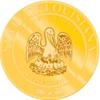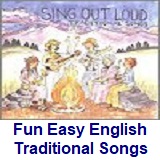Louisiana
State Flag
The state flag of Louisiana displays a white pelican
nurturing its young by tearing at its own breast (signified
by three drops of blood), with a white banner below
containing the state motto in blue letters (Union, Justice,
and Confidence); all on a field of blue.
Flags and heraldic symbols sometimes stray from the facts -
pelicans are known for their attentive nurturing of chicks,
but do not really tear at themselves to feed them
(self-preservation is the norm in nature, not
self-sacrifice). Mark Shields, author of the Brown Pelican
account for Birds of North America (BNA) Online (the
definitive source for scientific information about our
birds) says:
"Pelicans do NOT tear at their own flesh to feed their
young. This legend, which has taken on some religious
significance as a symbol of self-sacrifice, dates back to at
least medieval times. It may have begun as a result of
misinterpretation of normal feeding behavior, in which the
parent holds it bill down along its breast as young reach in
to take fish from the parent's bill or pouch. The truth is
that pelican parents, facing starvation, would abandon their
young and save themselves."
The pelican has been a symbol of Louisiana since colonial
times. The pelican is found on Louisiana's state seal, state
painting, and is one of three Louisiana symbols that appear
on the U.S. Mint's Louisiana bicentennial quarter. Ten very
different flags have flown over Louisiana:
Spanish Flag of Leone & Castile
French Fleur-de-Lis (LaSalle) [1682]
British Grand Union [1763]
Bourbon Spain [1769]
French Tri-Color [1803]
U.S. Flag of 15 Stars [1803]
West Florida Lone Star
Independent Louisiana (1861)
Confederate Flag (1861)
Louisiana Flag [1912]
Pledge to Louisiana Flag
Louisiana officially recognized a state pledge in 1981:
I pledge allegiance to the flag of the state of Louisiana
and to the motto for which it stands:
A state, under God, united in purpose and ideals,
confident that justice shall prevail
for all of those abiding here. |
|
Source:
State Symbols USA |
|
|
 Louisiana
State Facts Louisiana
State Facts
Picture: state seal of Louisiana |
|
State Capital |
Baton Rouge |
|
Nickname |
Pelican State |
|
Motto |
Union, justice, and confidence |
|
Statehood |
April 30, 1812 (18th) |
|
Origin of Name |
Named in honor of France's King Louis XIV. |
|
Largest Cities |
New Orleans, Baton Rouge, Shreveport, Lafayette,
Kenner |
|
Border States |
Arkansas, Mississippi, Texas |
|
Area |
43,566 sq. mi.; 33rd largest |
|
State Bird |
Eastern Brown Pelican |
|
State Flower |
Magnolia (magnolia) |
|
State Tree |
Bald Cypress (taxodium distichum) |
|
State Song |
Give Me Louisiana |
 Travel and tourism
site for Louisiana - This state travel and territorial
tourism site provides ideas for your vacations, meetings, and more. Travel and tourism
site for Louisiana - This state travel and territorial
tourism site provides ideas for your vacations, meetings, and more. |
|
|
Louisiana Stories |
|
|
Natchitoches Christmas Festival
Have you ever seen a fireworks display at Christmas time?
In Natchitoches, Louisiana, Christmas celebrations include
fireworks, a parade, and the Festival of Lights. This festival
started in the 1920s, when the city's new chief electrician got the
idea that stringing Christmas lights along Front Street would be a
nice Christmas present from the Power & Light Department to the
citizens of the town. Local businesses donated money for the lights,
and every year since then the light show has expanded with more
lights and events to celebrate the Christmas season. In the late
1930s, the town started the fireworks displays and soon thereafter
started to hold parades, including a parade of Christmas-decorated
barges on the Cane River. The children's parade was started in the
1970s.
In addition to all the entertainment festival-goers can eat the
highly popular Natchitoches meat pie. Food vendors also offer
crawfish pies, funnel cakes, alligator, and other festival food. As
one festival-goer put it, "If it swims, flies, hops, or crawls, you
can find it there, deep-fried and on a stick." |
|
|
Louisiana French Music: The Heart & Soul of
Acadiana
Louisiana French music is a blend of many influences. Cajuns are
descendants of French Catholics who settled in what is now Nova
Scotia, Canada, in the 1600s (during this time, Nova Scotia was
called Acadia). These Acadians brought their French folk music with
them, mostly ballads and instrumental music for dancing, which they
loved to do. Their favorite instrument was the fiddle because it was
loud enough to be heard over dancers' shuffling feet.
In the 1750s, the British took over Acadia, and the Acadians were
forced to leave. Many escaped to Louisiana, where other
French-speaking people already lived. The people from Canada were
known as "Cajuns" (if you leave off the "A" in Acadian, and say "Cadian"
rapidly, it sounds like "Cajun"). The Cajuns took up farming,
trapping, and fishing, often living in isolated swamp areas. Their
music was influenced by their new Spanish, German, African, Celtic,
Native American, and Caribbean neighbors, who also made Louisiana
their home. By the 1920s, accordions became popular, and they were
also used in Cajun and Creole music because they were loud and could
be easily heard.
Today, Cajun music is popular not only in Louisiana but also
nationwide. Cajun music is distinctively American because America is
one of the few places in the world where so many people of different
heritages settled. This mix of people is what makes our nation's
culture so interesting. |
|
|
"Fat Tuesday" in Louisiana
What city has the most famous "Fat Tuesday" celebration?
New Orleans.
Mardi Gras, which is French for "Fat Tuesday," is a big festival
that takes place the Tuesday before Ash Wednesday. Ash Wednesday is
the first day of Lent -- a symbolic period of fasting and penance
for many Christians. The two weeks before "Fat Tuesday" are the most
festive. Local carnival organizations called "krewes," the first of
which dates to 1857, hold almost nonstop balls and parades.
Individuals, given the honor of riding on elaborately decorated
floats in the parade, wear theme costumes and throw bead necklaces
and other trinkets to spectators. A French phrase that is often used
during these festivities is Laissez les bon temps rouler! or "Let
the good times roll!"
The melding of many heritages, such as Spanish, French, English, and
African American, has created a unique culture in New Orleans -- a
place famous for its rich musical tradition, its distinction of
being the birthplace of jazz, its food and its colorful Mardi Gras
celebrations. |
|
|
Louisiana Folklife Festival
Louisiana has a heritage of many cultures, nationalities and ethnic
groups, including Cajuns and Creoles. Do you know where Cajuns came
from? The Cajuns in Louisiana are descendants of the French-speaking
Acadians of Canada. Acadia is an early name for the Canadian
province of Nova Scotia. The Acadians were expelled after the French
lost the colony in 1755. A Creole is a person of mixed French or
Spanish and African descent.
In Monroe, Louisiana, each September, visitors can see all kinds of
traditional Louisiana crafts, hear music and storytelling, watch
dancing and try local foods at the Louisiana Folklife Festival.
There's even a Kids Stage, where young people perform.
Because of Louisiana's location by the Gulf of Mexico, seafood is
easily available. Seafood is used in many of the dishes that can be
sampled at the Festival, whether cooked in a Native American,
Creole, Cajun, or African American style. In addition to location,
history has played a big role in the foods of Louisiana. The state
that is now Louisiana has been a territory of France, Spain, and
Great Britain, and was even briefly an independent country! Have you
ever eaten such spicy, delicious seafood creations as gumbo,
jambalaya or crawfish boil? If you have the opportunity, try some! |
|
|
Indians in Louisiana: The Poverty Point Site
Why would anyone build mounds of earth 7 miles long?
In the case of Poverty Point, in northeastern Louisiana, no one
knows for sure. In some states, like Ohio, Native American people
built mounds as burial places. Archaeologists suspect that the
mounds at Poverty Point served as sites for dwellings, but they are
not certain. Native American culture in the Poverty Point area began
almost 4,000 years ago, and the mounds were built between 1750 and
1350 B.C.
The mounds are six giant half-circles in the shape of a bull's-eye,
almost three-fourths of a mile wide. If you straightened out the six
mounds and laid them out end-to-end, they would stretch for 7 miles.
Archaeologists believe the 37-acre central plaza formed by the
mounds may have been used for religious and other public ceremonies.
Although archaeologists have not found any articles of clothing from
these ancient people, they have found jewelry. The great variety of
this jewelry, from simple to elaborate, indicates that social status
was important in the Poverty Point community. Overall, Poverty Point
presents evidence that ancient Americans lived in sophisticated
communities. Even so, this does not help to solve the mystery of
exactly what these mounds were. Do you have any other ideas? |
|
|
Mardi Gras Season in New Orleans
Do you celebrate Fat Tuesday? If you live in New Orleans, Louisiana,
or any place else along the coast of the Gulf of Mexico, you
probably do.
Every year, the people of New Orleans celebrate Mardi Gras, which is
French for "Fat Tuesday." This holiday is the day before Ash
Wednesday, and it begins a season of fasting, called Lent, for many
Christians leading up to Easter Sunday. It's called Fat Tuesday
because it's the last day that many people eat meat and fatty foods
before Lent begins.
Today, Mardi Gras season in New Orleans is a time of merry-making
and festivity. Many clubs in the city, called krewes (pronounced
"crews"), sponsor extravagant parades and masked balls in the weeks
leading up to Fat Tuesday. It's a lot of fun to try to catch the
trinkets that are thrown to the crowds from the parade floats. Every
krewe has a king and queen, whose identities are kept secret until
the night of the ball. It's all part of the fun and mystery of Mardi
Gras. |
|
|
Isleños Society of St. Bernard Parish
Did you know that part of Louisiana used to be owned by Spain? In
1766, after the French and Indian War, France gave Louisiana to
Spain and Great Britain. Spain controlled the part of Louisiana west
of the Mississippi River and the Island of Orleans. But when the
Spanish learned that the British wanted to invade their part of the
province, they decided that more people needed to live there to
protect the area.
Spain turned to its colonies in the Canary Islands to find people to
move to Louisiana. The Canary Islands, located off the coast of
Africa, were the first colonial territory of the Spanish Empire and
Christopher Columbus's last stop before discovering the New World.
The people who lived there were called Canary Islanders, or Isleños
(pronounced ees-lane-yos), and they settled Louisiana between 1778
and 1783.
When the Isleños moved to Louisiana, they settled in four areas
around New Orleans to protect the city. St. Bernard Parish, just
five miles from downtown New Orleans, was settled in 1799. It was
the most successful settlement, and it still maintains a unique
Spanish identity. (In Louisiana, counties are called "parishes.")
The Isleños also brought their culture with them. Their lives
revolved mainly around family and the Roman Catholic Church.
In 1980, the Isleños Society of St. Bernard Parish founded the Los
Isleños Museum to preserve Louisiana's disappearing Spanish culture.
The elderly Isleños still speak a very old type of Spanish, brought
to Louisiana more than two centuries ago. More than 200 Isleños have
been interviewed and recorded in this old-style Spanish, and these
tapes have been collected by the museum. |
|
Source:
Library of Congress |
|
|
Cool America |
 About the U.S.A. About the U.S.A.
About the U.S.A. is an American
Studies reader that examines the customs, government, and history of the
United States of America. The text provides a wealth of information on U.S.
geography and history; the roles of local, state, and federal government;
national holidays and symbols; the Constitution; and citizenship. The book,
which was written for intermediate to advanced learners of English, contains
a range of activities for language students to practice listening, speaking,
reading, and writing. (opens to a new PDF window)
Great English reading
practice. |
 About
America About
America
Learn about the fascinating history and government of
the United States of America. Lessons include content on
American Government, American History, and Integrated
Civics. Handouts with interactive games and
student-centered activities encompass all four language
skills: speaking, listening, reading, and writing.
Great English reading practice for
beginning to intermediate students. |
 American Teens Talk! American Teens Talk!
Americans Teens Talk! is a collection of interviews of
American high school students. Each interview is accompanied by vocabulary
notes and discussion questions. The interviews in American Teens Talk! give
learners a view into the lives of adolescents in the U.S. Through the
written format of the interviews, learners are able to increase their
vocabulary, practice their reading and listening skills, engage in
discussions, and learn more about U.S. culture. These
interviews come with audio programs.
Great English listening and
reading |
 Sing Out Loud Children's Songs Sing Out Loud Children's Songs
Sing Out Loud Children's Songs includes popular children's songs in the U.S.A. Posters accompany the
individual Sing Out Loud Children's Songs. These
songs come with audio programs.
Great English listening and reading
practice. |
 Sing Out Loud Traditional Songs Sing Out Loud Traditional Songs
The Sing Out Loud Traditional Songs
collection contains 13 traditional American folk songs and song lyrics.
Listen to the songs online, read the lyrics, and collect the posters that
accompany the songs. These
songs come with audio programs.
Great English listening and reading
practice. |
 Sing Out Loud American Rhythms Sing Out Loud American Rhythms
Do you love music? Want to use it
to learn English? Check out the hip-hop inspired song "Peace" from Sing Out
Loud American Rhythms. American Rhythms includes a variety of musical genres
from many different artists in the U.S.A. These songs will appeal to teens
and young adults. These
songs come with audio programs.
Great English listening and reading
practice. |
 Route
66 - Famous American Road Route
66 - Famous American Road
U.S. Route 66 (US 66 or Route 66), also known as the Will Rogers Highway, the
Main Street of America or the Mother Road, was one of the original highways in
the U.S. Highway System. The highway, which became one of the most famous roads
in the United States, originally ran from Chicago, Illinois, through Missouri,
Kansas, Oklahoma, Texas, New Mexico, and Arizona before ending in Santa Monica,
California, near Los Angeles, covering a total of 2,448 miles (3,940 km). It was
recognized in popular culture by both the hit song "(Get Your Kicks on) Route
66" and the Route 66 television show in the 1960s. |
Route 66: The Highway That's the Best
(Beginner - Listening)
A video lesson which shows you an interesting place in America.
The English is
spoken at 75% of normal speed.
Great English listening practice.
This video shows travel along Route 66, the most famous road in
America. |
Chicago: The Start of Route 66
(Beginner - Listening)
A video lesson which shows you an interesting place in America.
The English is
spoken at 75% of normal speed.
Great English listening practice.
This video shows travel along Route 66, the most famous road in
America. |
Going West for Decades on Route 66
(Beginner - Listening)
A video lesson which shows you an interesting place in America.
The English is
spoken at 75% of normal speed.
Great English listening practice.
This video shows travel along Route 66, the most famous road in
America. |
Arizona: The Spirit of Route 66
(Beginner - Listening)
A video lesson which shows you an interesting place in America.
The English is
spoken at 75% of normal speed.
Great English listening practice.
This video shows travel along Route 66, the most famous road in
America. |
Route 66 California: The End of the Trail
(Beginner - Listening)
A video lesson which shows you an interesting place in America.
The English is
spoken at 75% of normal speed.
Great English listening practice.
This video shows travel along Route 66, the most famous road in
America. |
Ten Must-See Route 66 Attractions
(Beginner - Listening)
A video lesson which shows you an interesting place in America.
The English is
spoken at 75% of normal speed.
Great English listening practice.
This video shows travel along Route 66, the most famous road in
America. |
Four Famous Foods On Route 66
(Beginner - Listening)
A video lesson which shows you an interesting place in America.
The English is
spoken at 75% of normal speed.
Great English listening practice.
This video shows travel along Route 66, the most famous road in
America. |
International Tourists Drawn to Route 66
(Beginner - Listening)
A video lesson which shows you an interesting place in America.
The English is
spoken at 75% of normal speed.
Great English listening practice.
This video shows travel along Route 66, the most famous road in
America. |
|